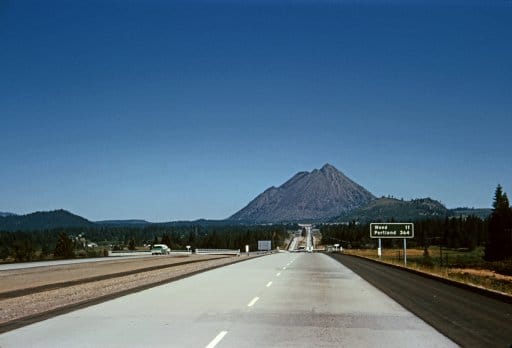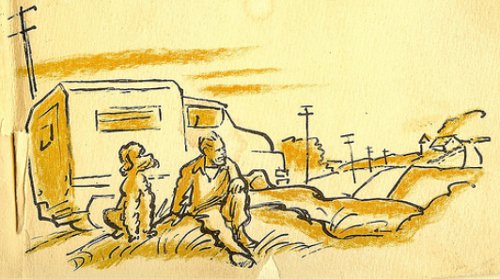
Editor’s note: This is a guest post from Jeff More.
Have you ever found yourself on a Wednesday afternoon at work wishing you could be camped out in the mountains this weekend? Stop telling yourself you can’t on such short notice, because you can. In one of AoM’s early articles, How to Streamline Your Next Camping Trip, Brett and Kate ran through the basics of pre-packing for the weekend. Today I’d like to revisit the camping bit and go a little more in-depth with how to take off and head for the hills on short notice.
In my life, I’ve found that what used to hold me back from a weekend of adventure was while I liked the idea of going somewhere, when faced with the prospect of going through the packing process and cruising into a National Park late at night only to spend hours combing campgrounds for an empty spot, thinking about sitting at home and playing Battlefield just sounded so much more appealing.
Then halfway through the weekend, I’d start feeling like I wasted the weekend when I could have done something more epic. So one day I decided to stop the cycle of regret, and I made the decision to systematically eliminate the barriers keeping me city-bound on my weekends and commit to finding a way to make weekend road trips a frequent affair. I’ve been successful in doing so by utilizing two road trip streamlining techniques: 1) finding dispersed camp spots, and 2) keeping a road trip bag packed.
An Impulse Road Tripper’s Best Friend: Dispersed Camping
What is dispersed camping?
If you live in the United States, the Bureau of Land Management (BLM) and US Forest Service (USFS), for the most part, allow “dispersed camping” in National Forests, which is camping in undesignated camp spots. These “primitive” camping areas don’t include any amenities such as toilets, trash cans, picnic tables, treated water, or fire grates, and so require campers to be self-sufficient, which happily keeps away the crowds. And best of all, camping in these areas is absolutely FREE.
With dispersed camping, you can head out and set up your tent somewhere on a whim. You may need to get a fire permit though (check the regulations in your state), which is as simple an affair as swinging by a US Forest Service office (or going online) and getting a little slip signed; once you’ve got that in hand, you’re good to go for the rest of the calendar year. The USFS permits are good for all USFS lands, so even if I pick up a permit in, say, the Los Padres National Forest, I can use it if I camp up in the Inyo National Forest too.
With dispersed camping, you get to go primitive and enjoy solitude, you don’t have to have the trip pre-planned or search in vain for a campsite, and you don’t have to pay any campground fees or deal with red tape–it’s truly a win-win-win, as far as I am concerned.
Finding a dispersed camping area
Finding dispersed camping areas will take some work at first (and you’ll probably make a few mistakes along the way), but discovering them is part of the adventure.
There are Forest Service maps available for $8 in many visitors’ centers and they usually carry maps for the surrounding districts as well. Keep in mind that if you have a favorite National Park to visit, they are often surrounded by National Forest land, and I would recommend scouting the Forest Service roads outside the entrance for a spot to your liking. Some of the back roads that I’ve found are my favorite places in the American West–many more so than the actual main drags of the big, crowded parks.
Note that different areas have different fire restrictions, as some places let you burn backpacking stoves but not the actual ground campfires you may be used to, such as in wildfire-prone Southern California. On other Forest Service lands, your glorious pyre, big enough to send smoke signals to the International Space Station, is fine as long as you police yourselves and drown it out later. There are usually big signs as you enter Forest Service boundaries that indicate what kind of fires are permitted.
Before you go, call the BLM and USFS offices and ask if they have any campfire, firearms (if you like plinking), or any other types of restrictions. Word of warning: USFS land is geographically expansive and broken up into districts with seemingly vague (to the public) boundaries, and you may be transferred when you call the main line. Often only a few or just one Ranger will be answering the phones on top of his/her other duties, so sometimes you will have to leave a message or be put on hold while they take care of a walk-in guest. Be patient–they are doing their best.
The US Forest Rangers I have met have all been very friendly and some have even recommended places for me and friends to camp and plink. Be specific and tell them you are looking for “dispersed camping” spots, otherwise they may think you are calling to find out about established campgrounds as most visitors do. Dispersed camping is generally allowed anywhere off the main road and away from civilization, but some spots are topographically and geographically better suited than others–a spot with a clearing big enough to see the Milky Way, an accessible stream, and a berm to shoot against is basically heaven to me.
Planning a Perfect Weekend Road Trip
I use the first evening spent dispersed camping as a launching off point to further destinations most people consider out of range for a weekend trip. For example, within an eight hour radius of Los Angeles, I have Yosemite, Kings Canyon/Sequoia National Parks, the Eastern Sierras, Zion, Grand Canyon, and Big Sur. Finding a place half or two-thirds of the way to these places to camp out Friday night lets me get a good night’s rest and tackle the remainder of the drive Saturday morning full of energy.
Here’s an example of my timeline going up the Eastern Sierras for a weekend:
- Friday 5:30pm, punch out of work.
- Friday 11:00pm, arrive at my scouted out camp up Highway 395 (normally 4 hours without traffic).
- Saturday 6:00am, arise, boil water for tea or coffee, grab a Pop Tart, jump in the front seat and start driving.
- Saturday 8:45am, arrive at trailhead in Yosemite National Park. Hike all day.
- Saturday afternoon: scenic drive through Yosemite National Park.
- Saturday night: camp in the Forest Service area in the area south of Yosemite.
- Sunday morning: half-day hike in the south portion of Yosemite.
- Sunday afternoon: drive home.
Or:
- Friday 5:30pm, punch out of work.
- Friday 8:30pm, arrive at my camp in the mountains north of Santa Barbara, CA. (Cold leftover) tacos and beer, read a book, go to sleep.
- Saturday 6:00am: arise, make tea, start driving.
- Saturday all morning: scenic drive up California’s Highway 1, stopping at every pullout, going on short walks in the Big Sur area.
- Saturday afternoon: sunset hike.
- Saturday night: camp in my scouted out camp spot off Hwy 1 in the Los Padres National Forest or sleep over with friends in Santa Cruz.
- Sunday morning: drive back down Highway 101.
- Sunday afternoon: half day hike at Pinnacles National Monument.
- Sunday night: drive home.
Gear and Packing Tips
There are no hard and fast recommendations here, and Brett’s idea of pre-packing a big plastic tub is pretty solid, but I thought I’d walk you through my configuration as a case study. My packing procedure is:
- Drag road trip bag to car Thursday night.
- Load leftovers from the workweek, some ice and beer into ice chest Friday morning, drag to car.
That’s it. On top of the weekend gear, I strongly advise you leave a few days of life-sustaining supplies and emergency gear in your car full-time.
For my car bag, I use a 4-cube Mountainsmith hauler (though milk crates should work, too) for the duration of the weekend. I also keep a small Camelbak I was issued back in the day loaded up with the Ten Essentials along with a camera and tripod, riding shotgun. And I personally always roll with 3-7 gallons of water in the car, as some of the places I frequent are desolate and bone dry. Since dispersed campgrounds don’t offer treated water, you’ll want to bring your own in the quantities you deem necessary, or bring along a way to purify the water you take from a stream.
My set up is somewhat spartan, but I like being on the road with an uncluttered car. Besides the obvious gasoline, I have no consumables I need to resupply for a weekend trip. Being mostly self-contained lets me focus on the moment and not worry about my physical needs.
The four-cube organizer is configured as follows:
- Toiletries, odds and ends.
- Food–Mountain House meals, cookset.
- Clothing–usually just one change of clothes, a pair of gloves, fleece, and a softshell jacket.
- Shelter–tent, pad, and sleeping bag.
Hint: most of the stuff overlaps for what you’d want in a Bug Out Bag, and if you have one, simply transfer the contents into your road bag before you leave, then restock your consumables (toiletries, fuel canisters, freeze-dried meals) and repack your Bug Out Bag when you get home. I like the cube bag to keep things tidy and appreciate the luxury of an ice cold beer at camp on a Friday night, but if you want to be extra manly, hit the road with just your BOB.
Speaking of Bug Out Bags, going on frequent weekend getaways hones your preparedness, allowing you to take stock of your material needs every time you come back and teaching you about your own personal limitations. Note the things you didn’t take and wish you had, and conversely, things you took that were completely useless that just got in the way. Refine and streamline your kit.
Now Hit the Road…Or At Least Be Ready To
Leaving your bags packed and marking dispersed camp locations takes care of the hard part, and all that is left to do is decide where you want to go. Now you can make a weekend of adventure happen as often as you want it to. Problem solved, problem staying solved.
Have fun and don’t forget to leave your travel plans with a trusted friend or loved one.
_________________________
Jeff More works and resides in Los Angeles, where the four seasons are mudslides, earthquakes, riots, and wildfires. He is an avid shooter of both firearms and camera, and celebrates his American heritage by playing the 5-string banjo. Check out his website at www.skunkabilly.com.







